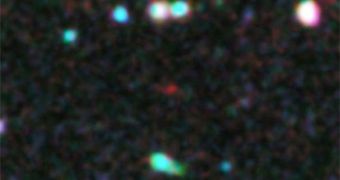Astronomers operating the Hubble Space Telescope believe they may have just discovered the oldest galaxy in the Universe. It appears in an ultra-deep field image taken with the powerful observatory, and initial estimates place it at a distance of about 13.2 billion light-years.
This means that the light it emits began its travels towards our planet just 550 million years after the Big Bang, and a couple of hundred million years after the first stars brought light to the Universe.
Experts have named the red, faint smudge they saw on Hubble's image UDFj-39546284, and are now awaiting confirmation of the discovery from other observatories. If validated, the galaxy candidate will become the earliest known in the entire Cosmos.
Investigators at the Leiden University in the Netherlands, led by expert Rychard Bouwens, say that this object could provide scientists with an insight into how the earliest objects and organized structures that ever developed looked like.
The findings might also shed more knowledge on the nature and possible appearance of primeval objects that have yet to be discovered, but which are bound to be lurking in the early Universe.
But astronomers might have to wait for a while before getting confirmation that UDFj-39546284 actually exists. One of the few observatories that could possibly see – the NASA James Webb Space Telescope – is not bound to take off until the end of the decade.
Early analysis of the distant object revealed that it is very small, featuring only young, blue stars. Astronomers say that it would take 100+ such galaxies to create a single Milky Way.
“We’re seeing huge changes in the rate of star birth that tell us that if we go a little further back in time we’re going to see even more dramatic changes,” explains University of California in Santa Cruz (UCSC) investigator Garth Illingworth, quoted by Daily Galaxy.
The discovery implies that the rate at which galaxies formed and developed increased considerably between the time UDFj-39546284 appeared and 650 million years after the Big Bang, when numerous other galaxies are known to exist.
“We’re moving into a regime where there are big changes afoot. Another couple of hundred million years back towards the Big Bang, and that will be the time when the first galaxies really are starting to build up,” Illingworth explains.
JWST will be capable of doing this, but Hubble is now stretched to the limits of the infrared wavelengths it can observe. Its successor will feature more advanced instruments that will allow it to peer even further back in time.

 14 DAY TRIAL //
14 DAY TRIAL //